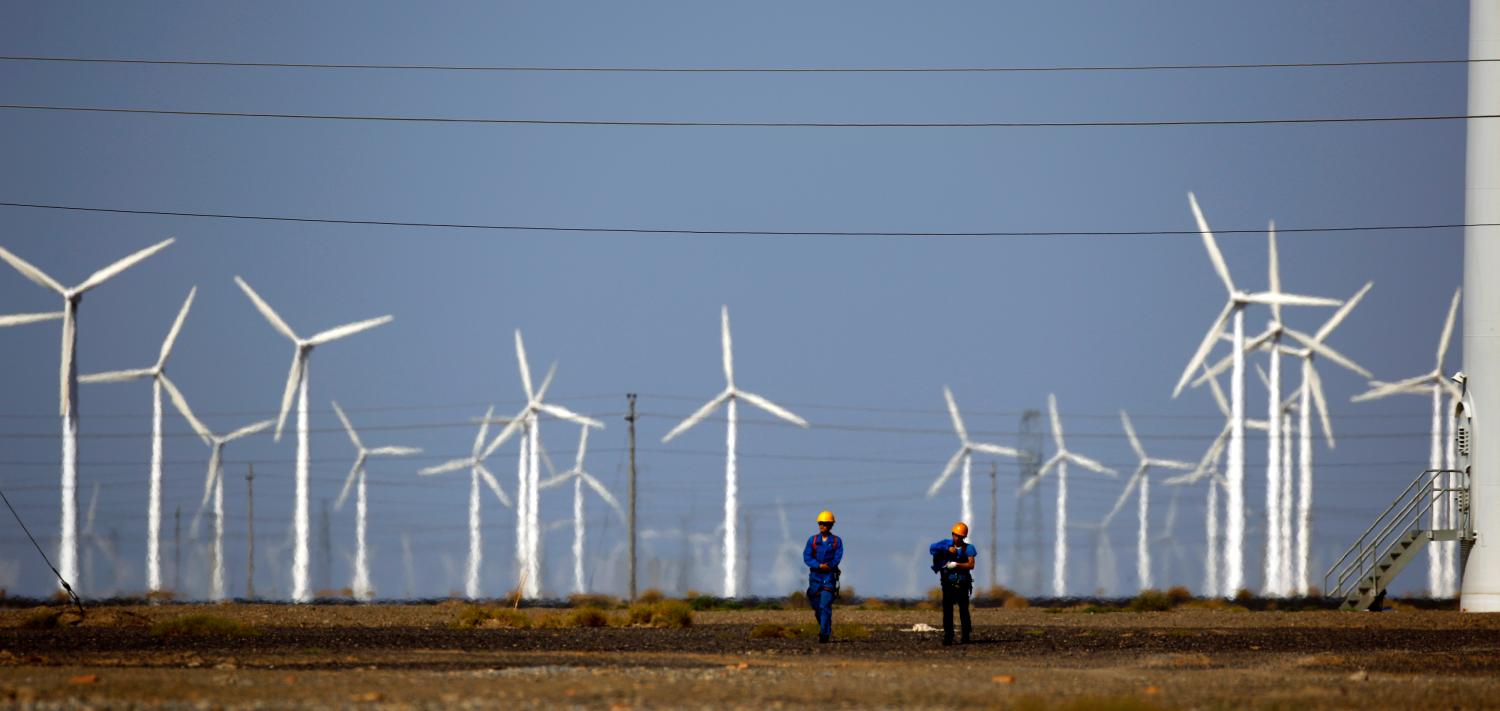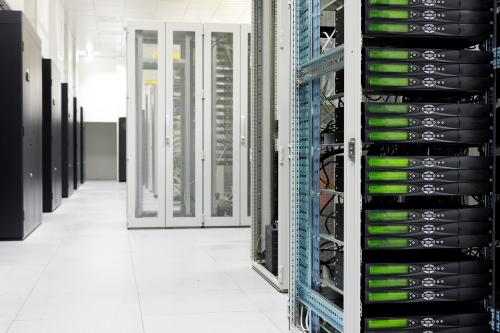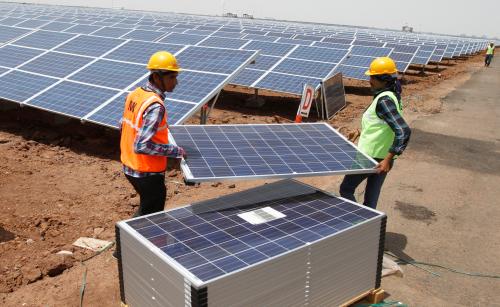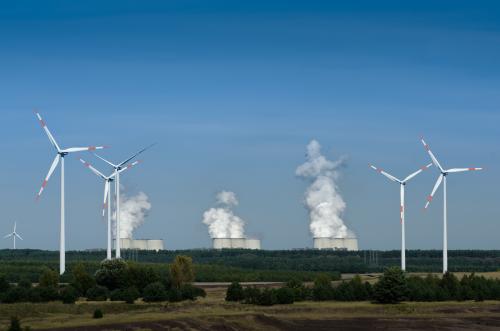This report is part of “A Blueprint for the Future of AI,” a series from the Brookings Institution that analyzes the new challenges and potential policy solutions introduced by artificial intelligence and other emerging technologies.
In a 2017 article for Foreign Affairs, Kassia Yanosek and I advanced the hypothesis that the biggest impacts of the information technology (IT) revolution may be felt far outside IT—in the traditional industries of oil, gas, and electricity.1 That’s because IT was transforming how those industries function. That logic of transformation may be especially profound when looking at a subset of the IT revolution: artificial intelligence (AI).
Other essays in this series explain what’s happening with AI and why it is such an important technical revolution.2 In this essay, I’ll look at how AI might be affecting the supply and demand for energy and the implications of AI for how modern society uses energy: climate change. In a nutshell, the message is that AI helps make markets more efficient and easier for analysts and market participants to understand highly complex phenomena—from the behavior of electrical power grids to climate change.
But AI itself won’t assure that outcome without clear policy incentives. Ironically, extremely smart energy markets lubricated by AI may make it easier to design good policy incentives while also making it easier for consumers to make choices about which energy services and products to buy that avoid the need to cut emissions. Even a big effort to control emissions will leave a lot of climate change—meaning that, in the future, much of “climate policy” will be focused on adapting to climate impacts and implementing quick responses in case of climate emergencies.3 Extremely intelligent systems for adapting to climate change impacts may make the cost of that adaptation more transparent and thus politically difficult to muster.
AI helps make markets more efficient and easier for analysts and market participants to understand highly complex phenomena—from the behavior of electrical power grids to climate change.
The impacts of AI are numerous, but four clusters of impacts seem most likely to affect energy and climate—two will alter the supply and demand for energy, and two will affect the ability of societies to understand how emissions are affecting the climate and how to manage those impacts.
AI impacts on energy supply
Most visible in the energy and climate space is the impact of AI on how energy is supplied. That’s because more intelligent energy supply systems, in effect, shift outward the supply curves. They take resources that are hard to tap and lower the cost. For example, machine learning systems can improve the ability to map and understand the size and value of underground deposits of oil and gas—in turn, making it easier to tap those resources at lower cost.
The same logic applies not just to traditional hydrocarbons that make up the backbone of the world’s energy system but also new non-hydrocarbon energy supply options. For example, AI-assisted training for the design and operation of wind and solar farms can make these systems much more efficient in how they take financial resources (i.e., capital) and generate electricity. In the case of wind farms, the turbine heads can be oriented actively to capture a greater fraction of the incoming wind—something that has been doable for a long time and can be made more efficient with machine learning. Similar learning can improve the quality of solar forecasting—for example, leading to better day-ahead and hour-ahead predictions of how clouds and other weather formations affect solar output. In turn, better forecasts can make it easier and more lucrative for solar generators to participate in electricity markets.
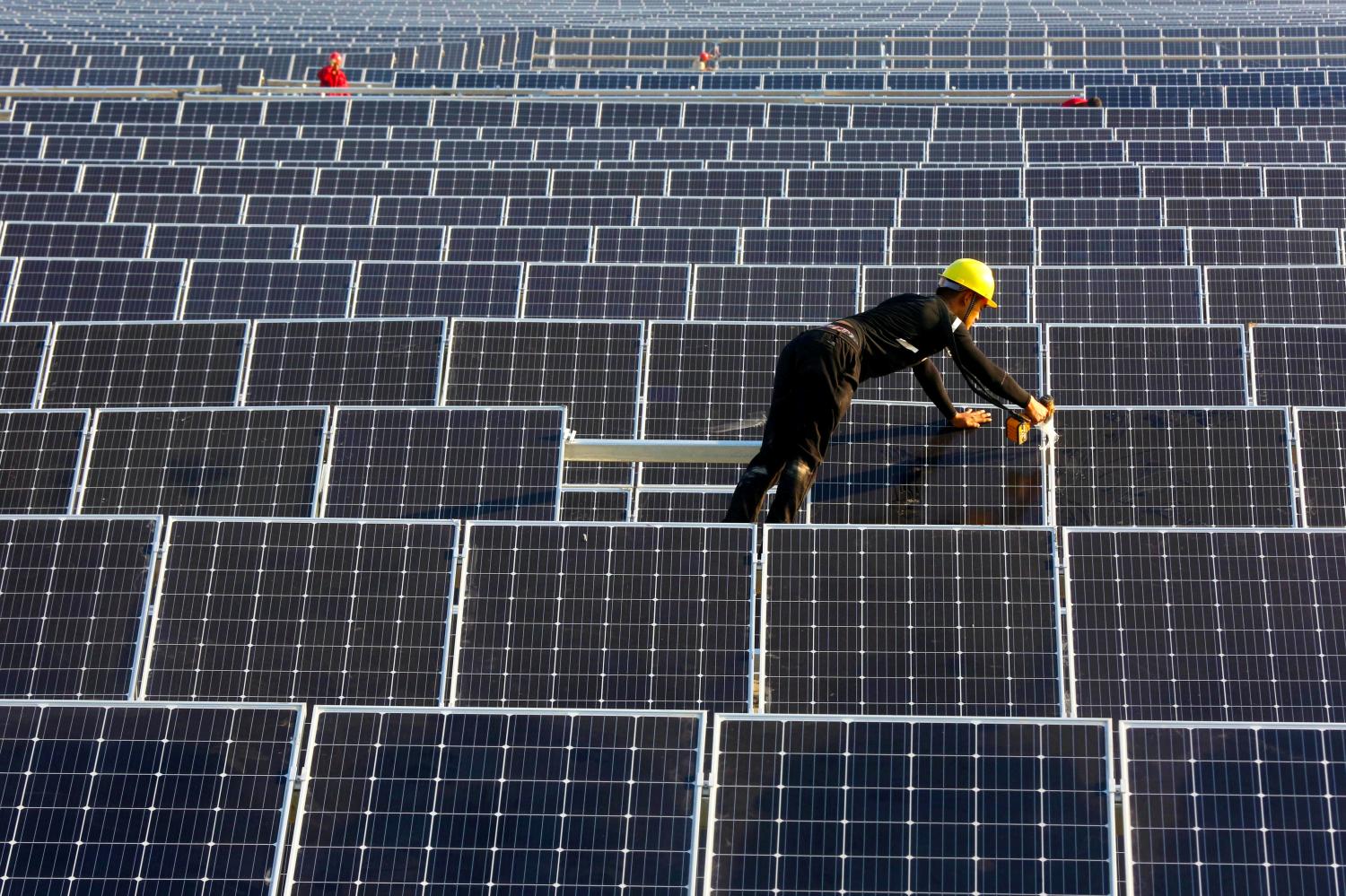
An interesting question is whether there is a “bias” in how AI-related technologies are affecting energy supply, such as whether they making traditional hydrocarbon suppliers more productive faster than they make zero-carbon renewables more productive? This is a hard question to answer because it requires disentangling the effects of many other technological changes (e.g., improved drill bits, control systems for horizontal drilling, better materials for wind turbine blades, and less costly solar cells) from the specific effects of AI. At the moment, my sense is that AI is having a bigger impact in oil and gas than in renewables because the kinds of activities that are unlocking new hydrocarbon resources—notably the shale revolution in oil and gas which requires mapping complex underground reservoirs and tailoring drilling methods4—are particularly well-suited to the recursive, complex learning processes that AI is well-suited to deliver.
AI impacts on energy demand and markets
While it isn’t clear whether AI will favor higher or lower carbon supplies of energy, the impacts of AI on energy demand are easier to pin down. All else being equal, systems that have large amounts of intelligence—and the capacity to update quickly in light of real-world conditions—are probably systems that are a lot more efficient. Efficiency will lower demand for energy and lower emissions. The effects are likely larger than one percent—already, simple “nudge” interventions in power markets, for example reminding customers about the need to reduce energy consumption during peak periods and changing the default settings on thermostats—yield energy savings up to a few percentage points. A hyper-smart AI-driven energy system should deliver even bigger reductions, in part because the changes needed (e.g., aligning energy consumption with real-time changes in energy markets) can be automated. That said, the savings are unlikely to be as large as the 60 to 100 percent reduction in emissions that scientists say will be needed in order to stop global warming.
While it isn’t clear whether AI will favor higher or lower carbon supplies of energy, the impacts of AI on energy demand are easier to pin down.
One of the great promises of adding AI to energy markets lies with linking what customers want (e.g., light and heat) with the exact range of options and market conditions for supplying those energy services. Machine learning is ideally suited for making fine-grained determinations of what customers want and then adjusting energy purchasing decisions accordingly. In theory, they could make a number of services that are already offered in today’s markets more powerful, such as:
- Purchasing green energy credits. Today, customers typically either “go green” or don’t. What they pay for green is a decision made rarely (often just at the time when a customer signs up). AI systems could better embed information about what customers are willing to pay for green energy and also offer different shades of green. Today, the green debate focuses on renewable power almost exclusively. In the future it could include other offers—for example, output from new nuclear reactors that are emission free.
- Adjusting power purchasing decisions. As power grids shift to play a much larger role for variable renewable generators, the price of power will become more variable, creating a greater social value from real-time adjustments in power purchasing. In California, for example, power prices may reliably become negative mid-day (when solar output is highest) and then spike as the sun sets but demand for air conditioning and lighting rises in the late afternoon. This is one reason why the default tariff for electricity starting in 2019 will be “time of use.” AI can allow even small consumers to automatically adjust their power consumption in real time with prevailing prices—something that ordinary people won’t do unless they like sitting at home staring at real-time data from power markets. (Some people do that; most prefer to live their lives.)
- Making electric supplies more reliable and bespoke to consumer needs. AI schemes could integrate data from hazards (e.g., extreme storms and fires) and then adjust grid operations accordingly—making the grid safer, more efficient, and more reliable. Already, a few utilities have installed self-healing grid systems—that is, automated surveillance and switching equipment that can identify faults on a grid, isolate them and restore power automatically. Conventionally, when the utility detects a fault—often because an irate customer calls, complaining of lost power—the response is to send a bucket truck with two guys who drive the lines, finding the trouble and then manually closing switches once the problem is fixed. Similarly, many customers now demand levels of reliability higher than what the grid can offer—and they purchase costly power conditioning, generation, and storage technologies. AI can help make purchase and operation of those systems much more efficient.
At present, the potential for these AI uses is barely tapped. A few utilities are experimenting with systems, some large customers are actively managing energy systems with AI-based systems (because they can afford to amortize the cost over large savings), and some firms like Stem are emerging as intermediaries—making explicit AI offers to customers and providing the expertise needed so that even small customers can utilize these systems.
How AI will improve climate modeling
Most human-caused changes in climate are rooted in how we use energy—in particular fossil fuels that, when combusted, intrinsically generate carbon dioxide (CO2). Thus, the changes discussed above—some leading to higher emissions, others to greater efficiency and lower carbon intensity—will affect the rate at which emissions flow into the atmosphere and accumulate. If the central message from the above discussion is that AI makes it possible for energy markets to reflect real-world conditions—and to be more efficient in matching consumer preferences with supplies—then there is no reason to believe that these more efficient markets, on their own, will tackle the carbon problem. Instead, they will require overt policy signals. For years, it has been thought that people often don’t respond readily to price signals, which is one reason why many analysts (and an even larger fraction of politicians) like direct regulation as a means of inducing reductions in emissions. Better and more efficient markets that can help consumers become more responsive to real-world conditions could help tamp down that enthusiasm for regulation and make practical a greater reliance on market-based instruments—such as carbon taxes.5
There is no reason to believe that these more efficient markets, on their own, will tackle the carbon problem. Instead, they will require overt policy signals.
AI could help radically improve the assessment of climate change. Today’s climate impact assessments rely on global-scale models of the climate system that are then downscaled to regional and local assessments. The downscaling process is complex and imperfect, in part because lots of local factors affect how broad changes in the climate are manifest where people actually live—along coastlines, near wildfire zones, in cities struggling with heat stress, and the like. AI makes it possible to connect the imperfect downscaling process with real information about actual impacts—reflected in insurance claims, weather extremes, the arrival of migrants, observed outbreaks, the spread of disease, and such. Already, the community of scientists that perform climate-impact studies are making use of such diverse data sources.6 AI could help automate and enrich that process, making real-time adjustments in climate-impact assessments feasible.
While these frontier opportunities are new, the idea of using machine feedbacks to improve model quality is hardly new in meteorology and climate modeling. For roughly two decades, there has been a systematic effort to compare climate models in terms of performance—that is, skill at forecasting temperature, precipitation, ice cover, and such. Those comparisons have probably made the models better and have also made the community much more aware of which models work best for different conditions. They have also made it easier for the Intergovernmental Panel on Climate Change (IPCC) and other bodies that conduct climate-science assessments to determine where the climate modeling community agrees and disagrees.
How AI will improve climate policy
Since the chief protagonist in the climate change story, CO2, has a long atmospheric lifetime, there is only a sluggish relationship between changes in emissions and the accumulated concentrations; in turn, those concentrations have a sluggish impact on the climate. Even if AI were part of some massive transformation in the energy system, the built-in inertia of that energy system, along with the inertia in the climate system, virtually guarantees that the world is in for a lot of climate change. All this is grim news and means that widely discussed goals, such as stopping warming at 1.5 or 2 degrees Celsius are unlikely to be realized.
These geophysical and infrastructural realities give rise to a new policy reality: adaptation is urgent.7 They also mean that emergency responses to extreme climate impacts—for example, solar geoengineering, might be needed as well.
Extreme climate change is going to be ugly and will require hard choices—such as which coastlines to protect or abandon. Without smart adaptation strategies, it will be a lot worse.
Existing research shows that there is a huge difference in the impact on public welfare from scenarios where climate change affects a society that doesn’t have an adaptation plan compared with a society that takes active adaptive measures. For example, the most recent U.S. climate-impact assessment released in November 2018 demonstrates that active adaptation measures can radically reduce losses from some climate impacts—often with benefits that far exceed the costs.8 Extreme climate change is going to be ugly and will require hard choices—such as which coastlines to protect or abandon. Without smart adaptation strategies, it will be a lot worse.
One of the central insights from the science of climate impacts is that extreme events will cause most of the damage. A world that is a bit warmer and wetter (and a bit drier in some places) is a world that societies, within reason, can probably adapt to—especially if those gradual changes are easy to anticipate. But a world that has more extreme events—put differently, climate events that have a higher variance—is a world that requires a lot more preparedness. A farming area that faces a new, significant risk of truly extreme drought for example, such as a decade-long dust bowl, will need to prepare as if that extreme event is commonplace. It will need irrigation systems, the option of planting hardier crops and other possible interventions that sit ready when the extreme events come.
Once those systems are purchased, much of the expense is borne and it makes sense to use them all the time. This has been the experience, for example, with the Thames river barrier or a similar Dutch flood barrier—these systems were designed and installed at vast expense with extreme events in mind, and now they are being used much more frequently. Climate impacts are, fundamentally, stochastic events centered around shifting medians—a warmer world, for example, is one where median temperature rises and where the whole distribution of temperatures from cold to hot shifts hotter. But the tails in that statistical distribution also probably fatten, and for some impacts, those tails get a lot fatter. Machine learning techniques will probably improve the ability to understand the shapes of those tails.
This logic of extreme events as the main drivers of climate impacts and response strategies has some big implications for how societies will plan for adaptation and how AI can help—possibly in transformative ways.

First, AI can help focus and adjust adaptation strategies. Because uncertainty is high and extreme events are paramount, policymakers, firms, and households will not know where to act nor what expense is merited. They will have a large portfolio of responses, each with an option value. Machine learning can help improve the capacity to assess those option values more rapidly. Such techniques might also make it possible to rely more heavily on market forces to weigh which options generate private and public welfare—if so, AI could help reduce one of the greatest dangers as societies develop adaptation strategies, which is that they commit vast resources to adaptation without guiding resources to their greatest value. High levels of uncertainty, along with acute private incentives that can mis-allocate resources—for example, local construction firms and organized labor might favor some kinds of adaptive responses (e.g., building sea walls and other hardened infrastructure) even when other less costly options are available—mean that adaptation needs could generate a massive call on resources and thus a massive opportunity for mischief and mis-allocation.
Second, most adaptation efforts are intrinsically local and regional affairs. As a matter of geophysics, climate change harms public welfare when general perturbations in the oceans and atmosphere get translated into specific climatological events that are manifest in specific places—specific coastlines, mountainous regions, public lands, and natural ecosystems. As a matter of public policy, the actors whose responses have the biggest leverage on local impacts are managers of local infrastructures—coastal and urban planners, developers, city managers, and the like. Politically, this is one of the reasons why, despite all the difficulties in mobilizing action to control emissions, it is likely that as communities realize what’s at stake with adaptation, they will respond. Local responses generate, for the most part, local benefits. A big challenge in all this local response, however, is that local authorities are intrinsically decentralized and usually not steeped in technical expertise. Getting the best information on climate impacts and response strategies—let alone keeping that information aligned with local circumstances and shifting odds for climate impacts—is all but impossible. AI could help lower that cost and, in effect, democratize quality climate impacts response.
Third, and perhaps most importantly, the single strongest result from studies assessing climate impacts is that poor communities will be hit harder than the rich. That’s because responding to climate impacts is often costly and because the kinds of factors that help explain wealth—good government and low levels of corruption—also explain which societies are most likely to adopt smart adaptation measures. The poor are on the front lines of climate change and, for the most part, will suffer the most as reflected in relative loss of welfare and loss of life and opportunity. To the extent that AI democratizes and improves the quality of understanding and responding to climate impacts, it may differentially help the societies that otherwise would be least able to respond. From a climate perspective, then, the AI revolution could end up being a vitally important part of assuring and promoting economic development amongst the world’s least well off—a topic that another paper in this series explores.9
Final thoughts
To close, I will make two points. First, AI has the potential to make energy markets a lot more powerful—by unlocking new supplies, reducing transaction costs, and making it easier for users to specify what they want to buy in the market. Efficient markets are great, but they also mean that market failures can become more rampant. Climate change is perhaps the largest market failure the world has seen so far—emissions of warming gases have global external consequences and the failure to impose emission taxes or other incentives means that firms and individuals are causing higher emissions and greater externalities than warranted. AI can transform markets, but the markets won’t transform emissions without clear signals. Mustering the political ability to put those signals into place and coordinate across countries remains as much a problem today as it was 30 years ago—and AI has had essentially no impact on that.
Second, as the world grapples with climate impacts and adaptation, it will probably discover that the line between “adaptation policy” and “good development” gets blurry. Some of the most important adaptation policies are also among the most important development policies. For example, one way to cut the impacts of climate change on agriculture is to adopt early warning crop forecasting systems—so that farmers can adjust seeds, cropping methods, and planting times (among other variables) to reduce harmful impacts from the vagaries of weather. Those same systems make sense even without a changing climate. AI could help make these kinds of development-oriented activities and policies more efficient economically, and politically, administratively easier to adopt, and more democratic in their orientation.10 Insofar as that happens, AI will further blur the line between adaptation and development.
-
Footnotes
- David G. Victor and Kassia Yanosek, “The Next Energy Revolution: The Promise and Peril of High-Tech Innovation,” Foreign Affairs, July/August 2017, https://www.foreignaffairs.com/articles/2017-06-13/next-energy-revolution
- See Darrell M. West, “What is Artificial Intelligence?” (Washington, DC: Brookings Institution, October, 2018), https://www.brookings.edu/research/what-is-artificial-intelligence/, and Chris Meserole, “What is Machine Learning?” ?,” (Washington, DC: Brookings Institution, October, 2018), https://www.brookings.edu/research/what-is-machine-learning/
- Yangyang Xu, Veerabhadran Ramanathan, and David G. Victor, “Global warming will happen faster than we think.” Nature, December 5, 2018, https://www.nature.com/articles/d41586-018-07586-5
- David G. Victor and Kassia Yanosek, “The Next Energy Revolution: The Promise and Peril of High-Tech Innovation,” Foreign Affairs, July/August 2017, https://www.foreignaffairs.com/articles/2017-06-13/next-energy-revolution
- James A. Baker III, George P. Shultz, Henry M. Paulson Jr., Martin Feldstein, Ted Halstead, Thomas Stephenson, N. Gregory Mankiw, Rob Walton, “The Conservative Case for Carbon Dividends. Climate Leadership Council,” February 2017, https://www.clcouncil.org/media/2017/03/The-Conservative-Case-for-Carbon-Dividends.pdf
- Solomon Hsiang, Robert Kopp, Amir Jina, James Rising, Michael Delgado, Shashank Mohan, D.J. Rasmussen, Robert Muir-Wood, Paul Wilson, Michael Oppenheimer, Kate Larsen, and Trevor Houser, “Estimating economic damage from climate change in the United States,” Science, June 30, 2017, http://science.sciencemag.org/content/356/6345/1362
- Yangyang Xu, Veerabhadran Ramanathan, and David G. Victor, “Global warming will happen faster than we think.” Nature, December 5, 2018, https://www.nature.com/articles/d41586-018-07586-5
- Dzaugis, M.P., D.R. Reidmiller, C.W. Avery, A. Crimmins, L. Dahlman, D.R. Easterling, R. Gaal, E. Greenhalgh, D. Herring, K.E. Kunkel, R. Lindsey, T.K. Maycock, R. Molar, B.C. Stewart, and R.S. Vose, 2018: Frequently Asked Questions. In Impacts, Risks, and Adaptation in the United States: Fourth National Climate Assessment, Volume II [Reidmiller, D.R., C.W. Avery, D.R. Easterling, K.E. Kunkel, K.L.M. Lewis, T.K. Maycock, and B.C. Stewart (eds.)]. U.S. Global Change Research Program, Washington, DC, USA, pp. 1444–1515. https://nca2018.globalchange.gov/
- Jennifer L. Cohen and Homi Kharas, “Using big data and artificial intelligence to accelerate global development,” (Washington, DC: Brookings Institution, November 2018), https://www.brookings.edu/research/using-big-data-and-artificial-intelligence-to-accelerate-global-development/
- See Elaine Kamarck, “Malevolent soft power, AI, and the threat to democracy,” (Washington, DC: Brookings Institution, November 2018), https://www.brookings.edu/research/malevolent-soft-power-ai-and-the-threat-to-democracy/ and Jennifer L. Cohen and Homi Kharas, “Using big data and artificial intelligence to accelerate global development?,” (Washington, DC: Brookings Institution, November 2018), https://www.brookings.edu/research/using-big-data-and-artificial-intelligence-to-accelerate-global-development/

